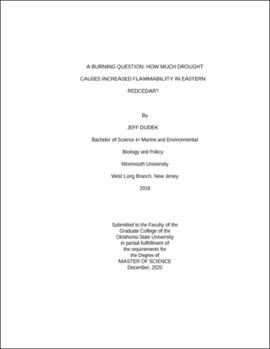| dc.contributor.advisor | Adams, Henry D. | |
| dc.contributor.author | Dudek, Jeff | |
| dc.date.accessioned | 2021-05-25T20:42:18Z | |
| dc.date.available | 2021-05-25T20:42:18Z | |
| dc.date.issued | 2020-12 | |
| dc.identifier.uri | https://hdl.handle.net/11244/329954 | |
| dc.description.abstract | Encroachment of eastern redcedar, Juniperus virginiana, due to fire suppression, is one of the greatest contributors to the degradation of North American grasslands. Mature trees are unlikely to burn during wet periods. However, during extended dry periods when live foliar moisture (LFM) approaches 80% they become more easily ignited and combustible. Currently, the amount of drought that is necessary to cause such reductions in LFM is unknown. To identify factors that contribute to wildfire risk I examined the relationship between leaf water potential and LFM in eastern redcedar. I used a dual greenhouse/field approach to link field conditions with changes in LFM and water potential. In the greenhouse, I designed a drought experiment to track LFM and leaf water potential in eastern redcedar. The field study was designed to relate greenhouse results to realistic field conditions. I chose 3 sites in Oklahoma with different levels of annual precipitation: Woodward (dry), Marena (moderate), and Cookson (wet). I measured LFM, water potential, and soil moisture in the field through a range of seasonal variation in climate. I used the Oklahoma Mesonet to identify other meteorological factors which contribute to changes in LFM. I found that leaf water potential can be used to predict LFM accurately and that relationship does not fluctuate based on site or previous drought conditions. Specifically, I observed a decline in LFM in two phases, a more rapid initial decline followed by a less rapid decline that is consistent with the onset of stomatal regulation in this species. Additionally, I identified a physiologically based model using metrics of soil water potential and vapor pressure data that I calculated from data available from the Oklahoma Mesonet to predict fire risk in eastern redcedar. Ultimately, my model can be used to predict LFM in populations of eastern redcedar across the state which can be used to improve fire risk predictions in Oklahoma. | |
| dc.format | application/pdf | |
| dc.language | en_US | |
| dc.rights | Copyright is held by the author who has granted the Oklahoma State University Library the non-exclusive right to share this material in its institutional repository. Contact Digital Library Services at lib-dls@okstate.edu or 405-744-9161 for the permission policy on the use, reproduction or distribution of this material. | |
| dc.title | Burning question: How much drought causes increased flammability in eastern redcedar? | |
| dc.contributor.committeeMember | Fishbein, Mark | |
| dc.contributor.committeeMember | Murray, Bryan | |
| dc.contributor.committeeMember | Fuhlendorf, Sam | |
| osu.filename | Dudek_okstate_0664M_16941.pdf | |
| osu.accesstype | Open Access | |
| dc.type.genre | Thesis | |
| dc.type.material | Text | |
| dc.subject.keywords | leaf water potential | |
| dc.subject.keywords | live fuel moisture | |
| dc.subject.keywords | oklahoma | |
| dc.subject.keywords | soil water potential | |
| dc.subject.keywords | vapor pressure deficit | |
| dc.subject.keywords | wildfire models | |
| thesis.degree.discipline | Plant Biology, Ecology and Evolution | |
| thesis.degree.grantor | Oklahoma State University | |
